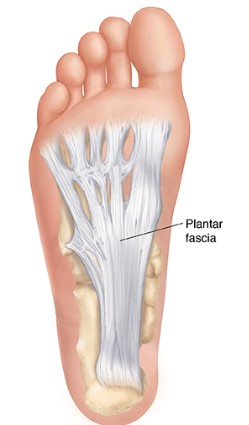
Plantar Fasciitis
The Plantar Fascia is a fibrous band that runs from the base of your heel to the balls of your feet. The purpose and function of your plantar fascia is to provide support, absorb forces, and propulsion during weight bearing activities like walking, running and jumping.
Plantar fasciitis develops when the plantar fascia is overused, overstretched, and irritated. This type of stress causes inflammation and mild tearing throughout the tissue.
10% of the population will be affected by plantar fasciitis in their lifetime. 25% of those patients will experience the condition in both feet. Excessive stress on the feet is the primary risk factor for developing plantar fasciitis. People at risk include endurance runners and athletes, occupations that require a lot of walking or standing, and being overweight.
The most common symptoms that are described in our offices are pain in the heel or arch of the foot. This pain is most prominent first thing in the morning and when standing or walking. Pain can often improve throughout the day as the muscles and fascia become loose and stretched and circulation/blood flow increases. Unfortunately, symptoms may resurface throughout the day as the condition worsens.
How can you manage Plantar Fasciitis?
Plantar fasciitis can be a frustrating condition, often lasting 18 months or more if left untreated. Fortunately, you may recover more quickly with proper treatment. One of the most important things that you can do is to make sure that you are wearing shoes with good arch supports on a consistent basis. A period of rest may be necessary to help you recover. Runners may need to temporarily decrease mileage or switch to less stressful activities like swimming, cycling, or using an elliptical machine. Strengthening the muscles of the foot will take stress off the plantar fascia by providing additional support in the foot.
- Proper shoes with appropriate support while healing.
- Appropriate rest or modifying activity to reduce stress on the fascia. Runners may run less miles or change activity to swimming/cycling etc.
- Strength training for the legs, calves, and muscles of the foot.
When these efforts fail we are ready to assess and develop a treatment plan that suits your goals and needs.
What are some treatment techniques that are common at MVMT Chiropractic?
Shockwave Therapy is considered one of the gold standards of treatment for plantar fasciitis. Many studies demonstrate success in reducing pain and improving function with success rates as high as 60–80%. MVMT has utilized this therapy specifically for plantar fasciitis to help many of our patients.
Learn more about Shock Wave Therapy
Manual therapies to the foot and lower legs can reduce tension on muscles that may stretch or create tensile stress on the plantar fascia. This includes dry needling, myofascial release and massage.
Learn more about manual therapy techniques
Cold laser therapy can quickly impact inflammation, help stimulate blood flow, and increase energy production of cells and tissues. All of these can help with the healing process of plantar fasciitis and reduce the healing time.

Trusted by the Houston Running Community
MVMT Chiropractic has been heavily involved in the Houston Running Community through club sponsorships, race sponsorships, and trying to elevate the community through treatment and education. These types of affiliations have allowed MVMT to treat a number of weekend warriors and athletes with lower leg injuries like plantar fasciitis.
